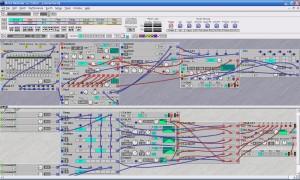As you may have guessed I have an affinity for all things analogue so this next post could be a bit of a shock…
I’ve bought a digital synth that I think is brilliant! I have been re-aquainting myself with my old Nord Modular (G1) so when I was offered a Nord Modular (G2) recently I decided that it was time to upgrade as the newer version had some important improvements that were worth having.
Firstly, you get a keyboard and some modulation controls. Secondly you get a better user interface (more displays). Thirdly, you have effects modules such as reverb and stereo delay. But that isn’t the whole story…
As a test of what could be done I considered how you could re-create something like a Novachord. The Novachord was the first polyphonic synth dating from the late 1930s with something like 160 odd valves in it with very crude controls but due to the way the oscillators work (one for each note in the top octave, then loads of divider circuits) everything sounds rather warm. The problem then was to recreate the subtle tuning discrepancies and other general vagueness as well as duplicating the restricted controls of the original.
Thinking the Nord wouldn’t be able to do this, I started patching away. First bit was easy, 12 voices, variable shape oscillator to create the core waveshape which was mainly sawtooth but a bit bent. The variable shape oscillator managed that, with an additional narrow pulse an octave above synched to the first oscillator to simulate the switching glitch caused by the dividers. So far so good. Next the scanner vibrato – a bit more of a challenge, basically the original is a number of very short delays derived from a chain of capacitors, a mechanical switching system then determines how many delays are applied and the delayed signal is then summed with the original. Bit like a chorus pedal.
The filters of the Novachord were simple to replicate as they were all fixed. The filters were put in the FX area so only one instance of each for the entire instrument. The controls of the original were replicated by switching control values using fixed constant value modules to give the reduced resolution.

Final problem was the vague tuning. That was achieved by combining the voice number output with a control sequencer to apply a small tuning offset to each voice. A similar arrangement was constructed to slightly offset the scanner speed as there was more than one scanner line in the original.
The only sad note here is that at the point that I discover (and buy) a Nord Modular G2, Clavia have decided to discontinue it. Shame…